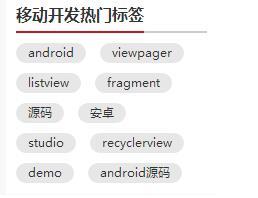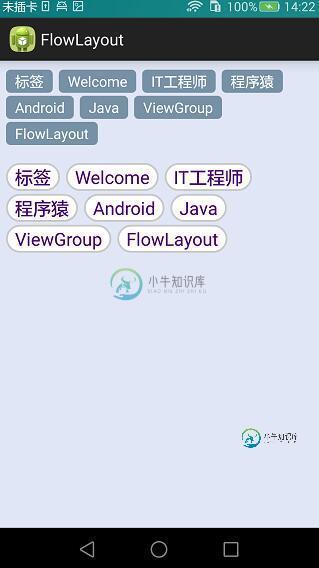Android自定义ViewGroup之FlowLayout(三)
本篇继续来讲自定义ViewGroup,给大家带来一个实例:FlowLayout。何为FlowLayout,就是控件根据ViewGroup的宽,自动的往右添加,如果当前行剩余空间不足,则自动添加到下一行,所以也叫流式布局。Android并没有提供流式布局,但是某些场合中,流式布局还是非常适合使用的,比如关键字标签,搜索热词列表等,比如下图:

定义FlowLayout
LayoutParams,onLayout的写法都和上一篇讲WaterfallLayout一模一样,在此不再赘述了,没看过的可以参照上一篇Android自定义ViewGroup(二)之WaterfallLayout。
在这里主要说的是onMeasure方法,注释见下方:
@Override
protected void onMeasure(int widthMeasureSpec, int heightMeasureSpec) {
super.onMeasure(widthMeasureSpec, heightMeasureSpec);
// 获得它的父容器为它设置的测量模式和大小
int sizeWidth = MeasureSpec.getSize(widthMeasureSpec);
int sizeHeight = MeasureSpec.getSize(heightMeasureSpec);
int modeWidth = MeasureSpec.getMode(widthMeasureSpec);
int modeHeight = MeasureSpec.getMode(heightMeasureSpec);
int childCount = getChildCount();
// 如果是wrap_content情况下,记录宽和高
int wrapWidth = 0;
int wrapHeight = 0;
//记录每一行的宽度,width不断取最大宽度
int lineWidth = 0;
//每一行的高度,累加至height
int lineHeight = 0;
// 遍历每个子元素
for (int i = 0; i < childCount; i++) {
View child = getChildAt(i);
// 测量每一个child的宽和高
measureChild(child, widthMeasureSpec, heightMeasureSpec);
// 得到child的lParams
LayoutParams lParams = (LayoutParams) child.getLayoutParams();
// 当前子空间实际占据的宽度
int childWidth = child.getMeasuredWidth();
// 当前子空间实际占据的高度
int childHeight = child.getMeasuredHeight();
// 如果加上当前child,则超出最大宽度,然后开启新行
if (lineWidth + childWidth > sizeWidth) {
//记录新行头一个标签坐标,为onLayout做准备
lParams.left = 0;
lParams.top = wrapHeight + lineHeight + vSpace;
lParams.right = childWidth;
lParams.bottom = lParams.top + childHeight;
//取最大的,注意这里lineWidth是包括右侧hSpace的,需要减掉
wrapWidth = Math.max(lineWidth - hSpace, childWidth);
// 重新开启新行,开始记录,可以看到行宽包括最右侧hSpace
lineWidth = childWidth + hSpace;
// 叠加当前高度,同理,加上下侧vSpace
wrapHeight += lineHeight + vSpace;
// 开启记录下一行的高度
lineHeight = childHeight;
} else {
//记录每一个标签坐标,为onLayout做准备
lParams.left = lineWidth;
lParams.top = wrapHeight;
lParams.right = lParams.left + childWidth;
lParams.bottom = lParams.top + childHeight;
//在本行追加标签,累加值到lineWidth,lineHeight取最大高度
lineWidth += childWidth + hSpace;
lineHeight = Math.max(lineHeight, childHeight);
}
// 如果是最后一个
if (i == childCount - 1) {
//将当前记录的最大宽度和当前lineWidth做比较,取较大值
wrapWidth = Math.max(wrapWidth, lineWidth - hSpace);
//布局高加上最后一行高
wrapHeight += lineHeight;
}
}
setMeasuredDimension((modeWidth == MeasureSpec.EXACTLY) ? sizeWidth : wrapWidth, (modeHeight == MeasureSpec.EXACTLY) ? sizeHeight : wrapHeight);
}
使用FlowLayout
直接看xml吧,一看便知:
<LinearLayout xmlns:android="http://schemas.android.com/apk/res/android" xmlns:tools="http://schemas.android.com/tools" xmlns:attr="http://schemas.android.com/apk/res/com.hx.flowlayout" android:layout_width="match_parent" android:layout_height="match_parent" android:background="#E1E6F6" android:orientation="vertical" > <com.hx.flowlayout.FlowLayout android:layout_width="match_parent" android:layout_height="wrap_content" android:layout_margin="10dp" attr:hSpace="20" attr:vSpace="10"> <TextView style="@style/flow_text_style_1" android:text="标签" /> <TextView style="@style/flow_text_style_1" android:text="Welcome" /> <TextView style="@style/flow_text_style_1" android:text="IT工程师" /> <TextView style="@style/flow_text_style_1" android:text="程序猿" /> <TextView style="@style/flow_text_style_1" android:text="Android" /> <TextView style="@style/flow_text_style_1" android:text="Java" /> <TextView style="@style/flow_text_style_1" android:text="ViewGroup" /> <TextView style="@style/flow_text_style_1" android:text="FlowLayout" /> </com.hx.flowlayout.FlowLayout> <com.hx.flowlayout.FlowLayout android:layout_width="match_parent" android:layout_height="wrap_content" android:layout_margin="10dp" attr:hSpace="20" attr:vSpace="10"> <TextView style="@style/flow_text_style_2" android:text="标签" /> <TextView style="@style/flow_text_style_2" android:text="Welcome" /> <TextView style="@style/flow_text_style_2" android:text="IT工程师" /> <TextView style="@style/flow_text_style_2" android:text="程序猿" /> <TextView style="@style/flow_text_style_2" android:text="Android" /> <TextView style="@style/flow_text_style_2" android:text="Java" /> <TextView style="@style/flow_text_style_2" android:text="ViewGroup" /> <TextView style="@style/flow_text_style_2" android:text="FlowLayout" /> </com.hx.flowlayout.FlowLayout> </LinearLayout>
这里写的比较啰嗦,所有TextView都是写在xml里面的,当然我们也可以通过Java代码来动态添加。
再来看看style吧,这里我们定义了两种不同的风格,具体见下面:
<style name="flow_text_style_1"> <item name="android:layout_width">wrap_content</item> <item name="android:layout_height">wrap_content</item> <item name="android:background">@drawable/flow_text_bg_1</item> <item name="android:textColor">#ffffff</item> <item name="android:textSize">16sp</item> </style> <style name="flow_text_style_2"> <item name="android:layout_width">wrap_content</item> <item name="android:layout_height">wrap_content</item> <item name="android:background">@drawable/flow_text_bg_2</item> <item name="android:textColor">#4B0082</item> <item name="android:textSize">20sp</item> </style>
找到background我们再进去看看,这里使用的是shapeDrawable,之后我会写一些关于shapeDrawable的文章:
<?xml version="1.0" encoding="utf-8"?> <shape xmlns:android="http://schemas.android.com/apk/res/android" > <solid android:color="#FFFFFF"/> <corners android:radius="40dp"/> <stroke android:color="#C9C9C9" android:width="2dp"/> <padding android:bottom="2dp" android:left="10dp" android:right="10dp" android:top="2dp" /> </shape>
效果图如下:

源码下载:http://xiazai.jb51.net/201609/yuanma/Android-FlowLayout(jb51.net).rar
以上就是本文的全部内容,希望对大家的学习有所帮助,也希望大家多多支持小牛知识库。
-
本文向大家介绍Android自定义ViewGroup之实现FlowLayout流式布局,包括了Android自定义ViewGroup之实现FlowLayout流式布局的使用技巧和注意事项,需要的朋友参考一下 整理总结自鸿洋的博客,希望可以帮到大家。 一、FlowLayout介绍 所谓FlowLayout,就是控件根据ViewGroup的宽,自动的往右添加,如果当前行剩余空间不足,则自动添加到下一行
-
本文向大家介绍Android自定义ViewGroup之第一次接触ViewGroup,包括了Android自定义ViewGroup之第一次接触ViewGroup的使用技巧和注意事项,需要的朋友参考一下 整理总结自鸿洋的博客:http://blog.csdn.net/lmj623565791/article/details/38339817/ 一、com.cctvjiatao.customviewg
-
本文向大家介绍Android进阶教程之ViewGroup自定义布局,包括了Android进阶教程之ViewGroup自定义布局的使用技巧和注意事项,需要的朋友参考一下 前言 在我们的实际应用中, 经常需要用到自定义控件,比如自定义圆形头像,自定义计步器等等。但有时我们不仅需要自定义控件,举个例子,FloatingActionButton 大家都很常用,所以大家也很经常会有一种需求,点击某个 Flo
-
本文向大家介绍Android自定义ViewGroup横向布局(1),包括了Android自定义ViewGroup横向布局(1)的使用技巧和注意事项,需要的朋友参考一下 最近学习自定义viewgroup,我的目标是做一个可以很想滚动的listview,使用adapter填充数据,并且使用adapter.notifyDataSetChanged()更新数据。 不过一口吃不成一个胖子(我吃成这样可是好几
-
本文向大家介绍Android中使用自定义ViewGroup的总结,包括了Android中使用自定义ViewGroup的总结的使用技巧和注意事项,需要的朋友参考一下 分类 自定义Layout可以分为两种情况。 自定义ViewGroup,创造出一些不同于LinearLayout,RelativeLayout等之类的ViewGroup。比如:API 14以后增加的GridLayout、design su
-
本文向大家介绍Android自定义ViewGroup实现流式布局,包括了Android自定义ViewGroup实现流式布局的使用技巧和注意事项,需要的朋友参考一下 本文实例为大家分享了Android自定义ViewGroup实现流式布局的具体代码,供大家参考,具体内容如下 1.概述 本篇给大家带来一个实例,FlowLayout,什么是FlowLayout,我们常在App 的搜索界面看到热门搜索词,就

